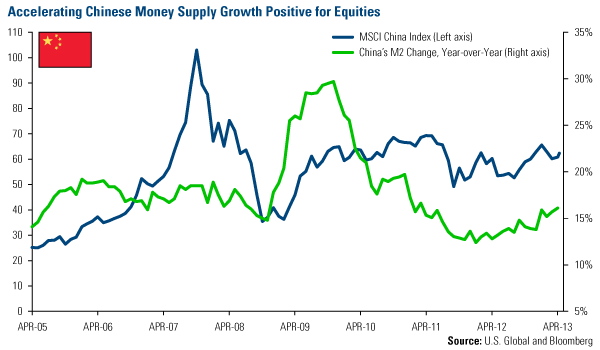Emerging Markets Radar (May 11, 2013)
Strengths
- The eurozone as a whole has posted two consecutive quarters of substantial current account surpluses with the rest of the world. Initially it was thought only a sustained boost in domestic consumption in Germany could pull the peripheral and eastern European countries back into a strong growth trajectory. The current situation bodes well for eastern European nations’ exports while retaining the optionality of a strong recovery in German inter-European imports.
- The Central Bank of Peru kept its benchmark interest rate unchanged at 4.25 percent for the 24th straight month while highlighting the historically low inflation, as well as the Bank’s view of the economy operating near its full potential. The mining industry, which dominates the local stock market, should be able to benefit from the low inflation and give a strong boost to the markets when commodities strengthen. As for this week, the Lima stock exchange is closing in positive territory, ahead of its main Latin American peers.
- China’s April money supply (M2) was up 16.1 percent, higher than the market expectation of 15.5 percent, while bank loans were RMB 792.9 billion, more than the estimated RMB 755 billion. Total social financing was RMB 1.75 trillion versus the market estimate of RMB1.5 billion and RMB2.5 billion in March. With faster credit expansion, the economy should grow well in the second and third quarters.
- China’s April CPI was still low at 2.4 percent, though a little higher than the consensus of 2.3 percent and 2.1 percent in March.
- China’s April exports went up 14.7 percent year-over-year versus the consensus 9.2 percent and 10 percent in March; imports were up 16.8 percent versus the consensus 13 percent and 14.1 percent in March. Although many analysts and journalists don’t believe the better-than-expected export numbers, citing lower exports to the U.S. and Europe and discrepancies between what China said it exported to Taiwan and what Taiwan said it had bought from Mainland China; the stock market reacted positively to the trade statistics. This might prove the point that the wisdom of crowds comes from general population or investors other than “informed” specialists.
- China’s State Council had two-day policy meetings in Beijing. The results are a list of reforms for 2013, e.g., interest rate liberalization, capital account convertibility and hukou reform. Those reforms are aimed at releasing the potential for industrial growth quality and efficiency, and to facilitate consumption and urbanization.
- China’s power generation improved in April as average daily power production was up 7.2 percent versus 2.4 and 5.2 percent for February and March, respectively, due to improved industrial demand, according to CICC.
- ; China’s April passenger vehicle sales went up 15 percent year-over-year, driven by new models. Domestic auto makers should be winners when government thrifty spending policies and anti-corruption policies are enforced by the central governments, while luxury brands are having short-term downside impact.
- Korea cut its benchmark interest rate by 25 basis points to stimulate the housing market and exports.
- Malaysia kept its benchmark rate unchanged at 3 percent, which economists and investors think is an appropriate rate after Malaysia’s ruling coalition, Barisan Nasional (BN), won the election to remain in control. Investors like that the economic policy will be in status-quo under the new government.
Weaknesses
- Turkey lost some ground this week relative to its eastern European peers as speculation that the possible sovereign credit re-rating by Moody’s would not take place until the end of the year. It appears the market was expecting the review to take place earlier in the year following the advancements highlighted by the agency in recent weeks.
- Venezuelan inflation soared to 4.3 percent month-over-month in April, significantly exceeding analysts’ expectations of a 3.0 percent rise. The central government, the sole provider of foreign currency, has only held one U.S.-dollar auction following the March elections, effectively making fewer dollars available for importers. This is especially problematic for a country that imports most of its consumption goods. In fact, the scarcity index, which tracks the amount of goods that are out of stock on the market, rose to 21.3 percent, the highest since the central bank began tracking the measure. Shortages of basic goods risk worsening both the fragile economy as well as the deteriorating social tensions.
- China’s April Producer Price Index (PPI) was down 2.6 percent versus down 1.9 percent in March, which showed weak downstream production demand for midstream materials and products. It also is the reason we believe inflation will stay low for a while, which would keep the People’s Bank of China (PBOC) accommodative.
- Malaysia’s March exports contracted 2.9 percent year-over-year, but better than a contraction of 7.7 percent in February this year. For the first quarter, exports fell 2.4 percent, mostly due to lower palm oil prices; imports were up 6.2 percent due to strong domestic demand. The decline in March industrial production eased to -0.2 percent year-over-year from -5.2 percent in February, but below consensus expectations for +0.2 percent.
- Indonesia’s GDP growth moderated to 6 percent in the first quarter of 2013, down from 6.1 percent in the fourth quarter of 2012, and consensus was 6.1 percent. The slower growth rate was due to weak exports and slower growth in gross fixed asset formation and domestic consumption.
Opportunities
- As shown in the graph above, money supply (M2) was up 16.1 percent in April. The PBOC has recently stayed in an easing monetary stand by injecting liquidity into the system, and the bank systems are lending out faster than the market expectation. This bodes well for the economy in the second and third quarters, particularly helping fixed asset investments and domestic consumption.
- Speculation of more monetary easing in the Czech Republic has been gaining momentum among policymakers in the past week. After four months with the benchmark rate at 0.05 percent, members of the Central Bank’s board have expressed their intention to increase monetary stimulus through foreign exchange intervention.
- Mexico had its sovereign debt rating raised to BBB+ from BBB by Fitch Ratings on Wednesday. The agency cited strong macroeconomic fundamentals, credibility in the inflation targeting and flexible exchange rate regimes, and greater commitment of the new administration in order to pass structural reforms. In addition, the Citibank Latin America Strategy team issued a positive report highlighting opportunities in the country’s staples, financials, and consumer discretionary sectors despite the recent earnings weakness.
- Mexico recently reported a $3.27 billion fiscal surplus for the first three months of 2013, as well as $6 billion in Japanese foreign direct investment over the last eight quarters. It can only be expected for this strength to give momentum to the economy and build on the competitiveness platform President Pena Nieto is submitting to Parliament. In addition, President Obama is on an official visit to Mexico this week and, despite the fact that the President is visiting mainly to discuss immigration and security, the trip presents an opportunity to touch on other bilateral items in the agenda such as immigration and trade.
Threats
- China’s April PPI was down 2.6 percent, showing weak demand for midstream products and fragile economic growth recovery. Particularly, the weak PPI statistics might reflect the fact that the small- to medium-sized firms, which are the driving forces in China’s exports, are facing weak external demand and headwind from the appreciating Yuan.
- Business Monitor International issued a report highlighting the current trend of the Russian current account balance and its implied rapid erosion of export competitiveness. The report demonstrates how lower oil prices, very low levels of export diversification, as well as ineffective measures to address the uncompetitive nature of non-oil exports are likely to bring Russia into a current account deficit scenario within the next five years.
- The government of President Dilma Rousseff appears to have lost coordination with Brazil’s congress at a pivotal time for approving structural reforms. Earlier this week the federal government pulled its proposed value-added tax reform, allegedly following multiple modifications introduced by congress which disfigured the original reform. In addition, the lower house failed to vote on a decree, backed at the federal level, to increase private investment in the ports, which are running at overcapacity and worsening the cost structure of export-driven industries.













